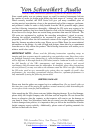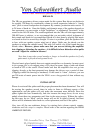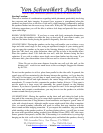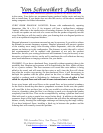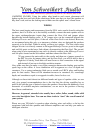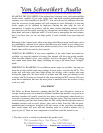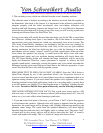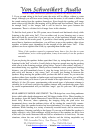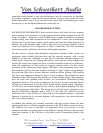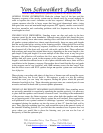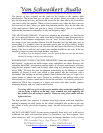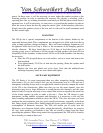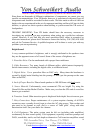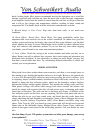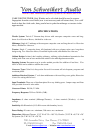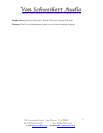
Von Schweikert Audio
930 Armorlite Drive, San Marcos, CA 92069
Ph (760)410-1650 Fax (760)410-1655
E-mail:albertvonn@aol.com
World Class Reference Speaker Systems for Music and Film
~ Website:www.vonschweikert.com
10
somewhat overly detailed, it may be possible that no rear fill is necessary nor desirable.
If you hear ‘brightness’ creep into the overall balance, it may be time to back off on the
Spatial Dimension Control. In a room that’s fairly dead, with soft sounding gear, it may
be necessary to use the Spatial Dimension control fully on.
BASS RESPONSE TUNING
BACKGROUND INFORMATION: Since enclosed rooms will affect the bass response
due to standing wave formation, a woofer-tuning feature has been designed into the VR
series of speakers. Deep bass in the 20-30Hz range is highly desirable in a reference
speaker design, since hall reverberation at low frequencies is a sonic clue to both depth
and hall size. Classical music simply sounds anemic and artificial without deep bass. In
addition, the wide dynamic range found in pop and jazz recordings depends on bass
‘slam’ and efficiency at low frequencies in order to sound like a live bass instrument
such as bass guitar, synthesizer, bass drums, and upright string bass.
For this reason, a hybrid triple-chambered transmission line/bass reflex system was
engineered which exhibits both deep bass and fast transient response, with a strong
emphasis on tight bass. Although it is true that the measured transient response of a
sealed woofer system has less ringing than hollow cavity type bass reflex cabinets (but
not the VR design), the trapped rear wave of sealed enclosures results in low efficiency,
while the compressed air load results in sluggish transient attack. For this reason,
transmission line loading has much appeal, and makes more engineering sense, since
both deep bass and fast transient response (resulting in “tight” sound) are optimized at
the same time. Bass reflex systems, however, which are hollow (lacking 100% stuffing
fill), have very unpleasant ‘hangover’ due to cavity resonance. This problem has been
eliminated in the VR design by the utilization of a high stuffing density. This technique
does not work with standard reflex woofers, nor conventional Theile/Small tuning
alignments, however. The resistive damping in the form of acoustic foam and Dacron
fill must be compensated in both the driver design and the cabinet tuning ‘alignment’.
All VR Series use custom designed drivers with very high magnetic damping (low Qes)
and stiff suspensions (high Qms). The tuning ratio is derived from a proprietary over
damped Theile/Small alignment with a total Q of less than 0.6, while the woofers
themselves have a total Q below 0.3. By using an over damped alignment, maximum
tightness is assured due to oversized magnets, stiff suspensions, over-sized enclosures,
and a low tuning frequency.
In addition, the midbass rise normally associated with dual woofer formats has been
eliminated by the use of Zobel conjugate networks in the VR-4 Series woofer crossover.
The inductor coils used at extremely low frequencies have to be massive to avoid
saturation and hence are quite expensive and difficult to design. However, the extremely
clean bass response of the VR series is the direct result of engineering taken to the
extreme.



